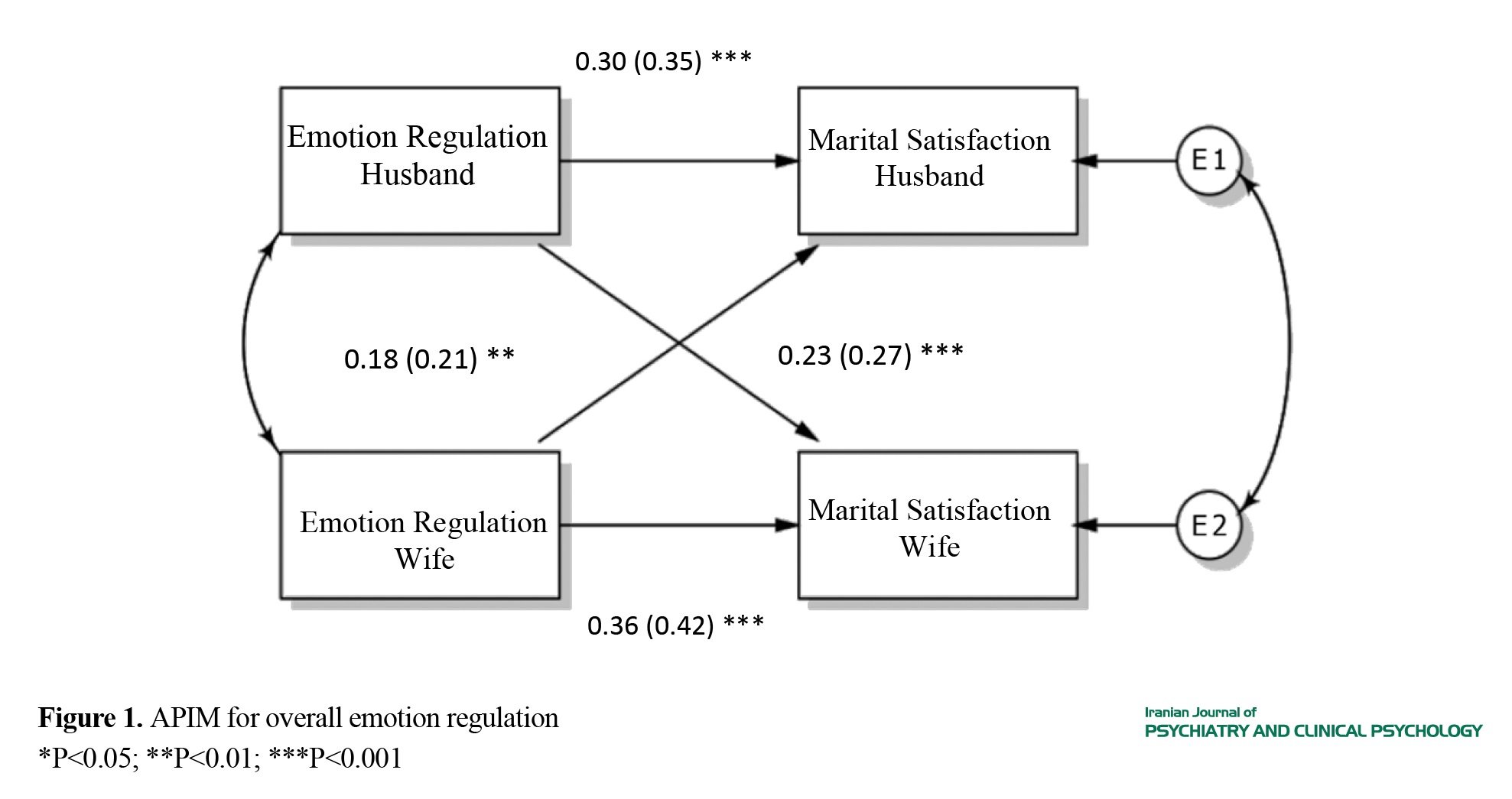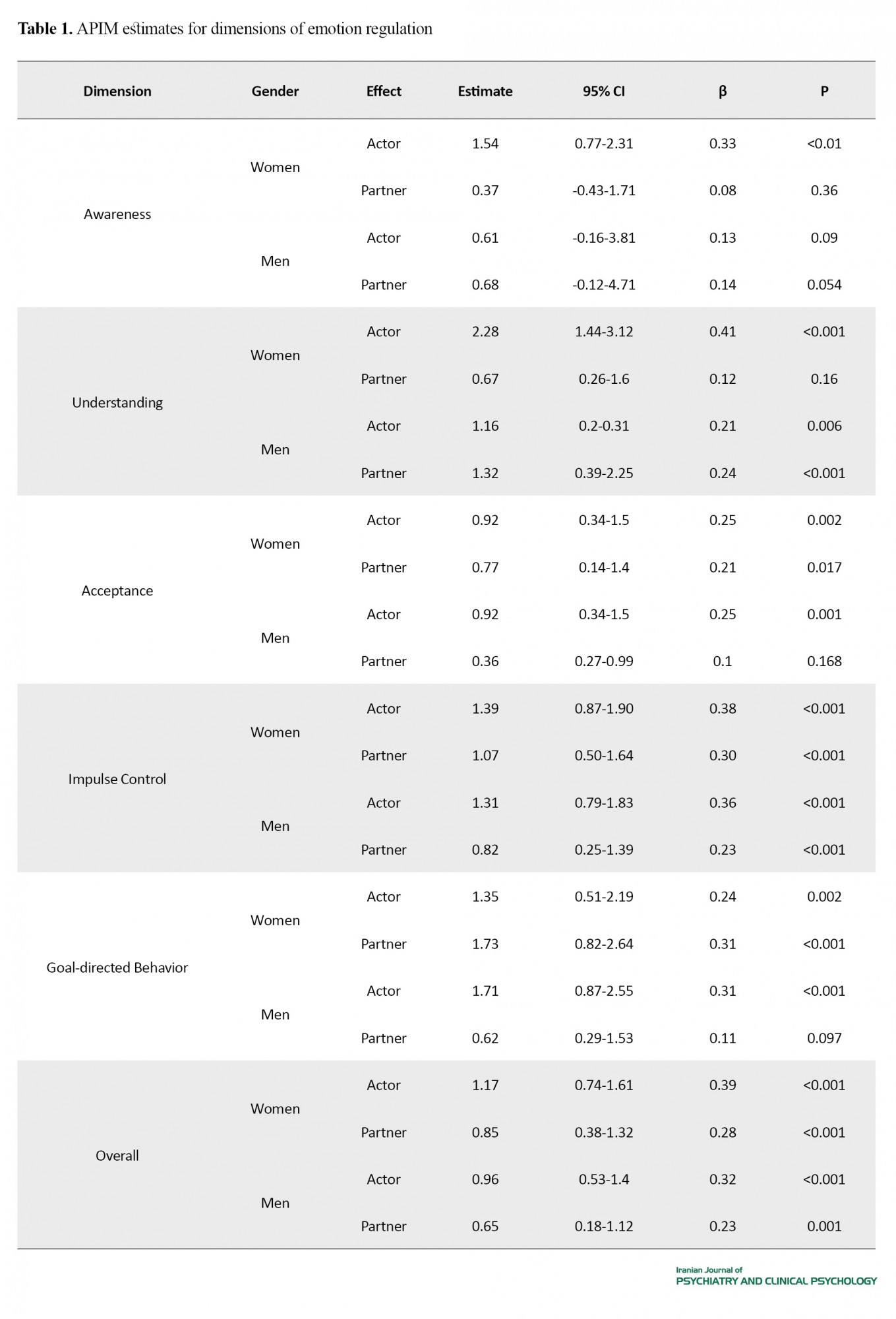BibTeX | RIS | EndNote | Medlars | ProCite | Reference Manager | RefWorks
Send citation to:
URL: http://ijpcp.iums.ac.ir/article-1-2965-en.html
2- Family Research Institute, Shahid Beheshti University, Tehran, Iran.
1. Introduction
During recent years, research has paid attention to the role of emotion regulation in interpersonal relationships. According to Gross [4], emotion regulation encompasses "the processes by which individuals influence which emotions they have, when they have them, and how they experience and express these emotions" (p. 275). Emotion regulation often takes place in social contexts and both influences and is influenced by our relationships with others. Research indicates that individuals who regulate their emotions more effectively, experience more positive social interactions and less conflict with peers [6]. Given the high levels of intimacy between couple partners, emotion regulation processes are expected to play a pivotal role in marital relationships. Since intimacy requires certain degrees of openness and vulnerability, intimate relationships tend to be emotionally challenging. In order to effectively respond to these challenges, partners need to possess a range of skills, including the ability to identify, appropriately express and manage emotions [7, 8]. Within the context of intimate relationships, each partner’s behaviors, emotional responses, and emotion regulation strategies may act as emotional stimuli for the other partner. Therefore, maintaining an optimal emotional atmosphere in the relationship relies on both partners’ regulatory capacities.
The majority of studies in this field have not taken account of the multidimensional nature of emotion regulation. Based on Gratz and Roemer’s theory, emotion regulation is not limited to controlling emotional responses but rather entails a set of abilities including: a) awareness of emotions, b) clarity of feelings, c) acceptance of emotional experiences, d) impulse control, e) access to emotion regulation strategies, and f) ability to engage in goal-directed behavior while experiencing negative emotions [11]. Some empirical evidence suggests that the dimensions of emotion regulation may independently contribute to the quality of marital relationships. For instance, in an analysis of couple seeking therapy, men and women’s access to emotion regulation strategies was positively associated with their own relationship satisfaction. In addition, women’s higher impulse control predicted more satisfaction for their partners. The study failed to find associations between overall emotion regulation and relationship satisfaction. Despite the valuable insights provided, these results were restricted to a relatively small clinical sample and cannot be generalized to community populations [20].
The present research aimed to investigate the relationship between the multidimensional construct of emotion regulation and marital satisfaction in Iranian couples. Considering the scarcity and inconsistency of evidence regarding gender differences in this domain, the study also attempted to assess the moderating role of gender in the relationship between emotion regulation and marital satisfaction.
2. Method
In light of the interconnected and recursive nature of emotion regulation in the couple context, data were collected and analyzed at a dyadic level. A group of 156 married heterosexual couples located in Tehran were recruited by convenience sampling. Using the Difficulties in Emotion Regulation Scale (DERS), participants rated themselves on 6 aspects of emotion regulation. They also reported their degree of relationship satisfaction by responding to the Dyadic Adjustment Scale (DAS). This study is among the first in Iran to use the Actor Partner Interdependence model (APIM). Actor and partner effects and the effects of gender (as the distinguishing variable) were estimated by Structural Equation Modeling.
3. Results
As displayed in Figure 1, both men and women’s ability to regulate emotions predicted their own and their partner’s relationship satisfaction. The model accounted respectively for 25% and 20% of the variation in women and men’s marital satisfaction.
Estimated actor and partner effects for each of the emotion regulation dimensions are presented in Table 1. It can be seen that women’s scores in all 6 aspects of emotion regulation and men’s scores in all aspects except from “awareness” predicted their own relationship satisfaction. Men’s acceptance of emotions, goal-directed behavior, impulse control, and access to emotion regulation strategies was positively associated with their wives’ satisfaction. Women’s impulse control, access to regulation strategies, and clarity of emotions was predictive of their husbands’ relationship satisfaction.
The test of the interactions of gender with the actor effect was not statistically significant, chi square (1) = 1.518 (p = .218), and the test of the interactions of gender with the partner effect was also not statistically significant, chi square (1) = 0.007 (p = .932). The combined test of the interactions of gender with both the actor and partner effects was not significant either, chi square (2) = 3.668 (p = .160). Therefore, the analyses did not support a moderating role for gender.
4. Discussion
Findings supported the hypothesis that emotion regulation is positively associated with self and partner marital satisfaction. The results are in line with previous research highlighting the effects of emotion regulation on the quality of relationships [10, 20, 40]. While Bloch et al. and Rick et al. found partner effects of emotion regulation only for women [10, 20], in the present study significant partner effects were traced for both women and men. Hence the results emphasize the interconnectedness between partners in the domain of emotions. Since gender did not moderate the relationships between emotion regulation and marital satisfaction, men and women’s emotion regulation abilities appear to be to the same extent predictive of their own and their partner’s satisfaction.
Based on their clinical observations, Levenson et al. state that although couples seeking professional help present different issues, almost all of them struggle with some kind of problem with the regulation of positive or negative emotions [9]. Many approaches to psychotherapy, including mindfulness and acceptance-based therapies and emotion focused therapy, focus on problems with emotions and emotion regulation [13, 50, 51]. The present study found significant relationships between dimensions of emotion regulation and marital satisfaction, pointing to the importance of understanding emotion regulation as a multidimensional construct. In the assessment of couple problems, paying attention to the different dimensions of emotion regulation could help therapists determine specific intervention targets.
Ethical Considerations
Compliance with ethical guidelines
The participants were informed about the aims and guidelines of the study. Questionnaires were coded and placed in individual envelopes in order to ensure the anonymity and confidentiality of obtained data. All subjects signed a written informed consent form.
Funding
This study did not receive any specific grant from funding agencies of the public or nonprofit sectors.
Authors contributions
Conceptualization, validation, review and editing: all authors; Methodology, data analysis, resources, writing: Fatemeh Riahi; Supervision: Mahmoud Golzari, Fereshteh Mootabi.
Conflicts of interest
The authors declare no conflict of interest.
Acknowledgements
We are grateful to all the participants involved in this research.
References
1.Proulx CM, Helms HM, Buehler C. Marital quality and personal well-being: A meta-analysis. Journal of Marriage and Family. 2007; 69(3):576-93. [DOI:10.1111/j.1741-3737.2007.00393.x]
2.Kiecolt-Glaser JK, Newton TL. Marriage and health: His and hers. Psychological Bulletin. 2001; 127(4):472-503. [DOI:10.1037/0033-2909.127.4.472] [PMID]
3.Whisman MA. Marital distress and DSM-IV psychiatric disorders in a population-based national survey. Journal of Abnormal Psychology. 2007; 116(3):638-43. [DOI:10.1037/0021-843X.116.3.638] [PMID]
4.Gottman JM, Levenson RW. Marital processes predictive of later dissolution: Behavior, physiology, and health. Journal of Personality and Social Psychology. 1992; 63(2):221-33. [DOI:10.1037/0022-3514.63.2.221]
5.Bradbury TN, Fincham FD, Beach SRH. Research on the nature and determinants of marital satisfaction: A decade in review. Journal of Marriage and Family. 2000; 62(4):964-80. [DOI:10.1111/j.1741-3737.2000.00964.x]
6.Rosen-Grandon JR, Myers JE, Hattie JA. The relationship between marital characteristics, marital interaction processes, and marital satisfaction. Journal of Counseling & Development. 2004; 82(1):58-68. [DOI:10.1002/j.1556-6678.2004.tb00286.x]
7.Iran’s National Oraganization for Civil Registration. [Marriage and divorce data (Persian)] [Internet]. 2020 [Updated 2020 June 21].
Available from: https://www.sabteahval.ir/avej/Page.aspx?ID=3257&Page=Magazines/SquareShowMagazine&mId=49826
8.Gross JJ. The emerging field of emotion regulation: An integrative review. Review of General Psychology. 1998; 2(3):271-99. [DOI:10.1037/1089-2680.2.3.271]
9.Gross, JJ, Richards JM, John OP. Emotion regulation in everyday life. In: Snyder DK, Simpson J, Hughes JN, editors. Emotion Regulation in Couples and Families: Pathways to Dysfunction and Health. Washington, D.C.: American Psychological Association; 2006. pp. 13-35. [DOI:10.1037/11468-001]
10.Lopes PN, Nezlek JB, Extremera N, Hertel J, Fernàndez-Berrocal P, Schütz A, et al. Emotion regulation and the quality of social interaction: Does the ability to evaluate emotional situations and identify effective responses matter? Journal of Personality. 2011; 79(2):429-67. [DOI:10.1111/j.1467-6494.2010.00689.x] [PMID]
11.Eisenberg N, Fabes RA, Guthrie IK, Reiser M. Dispositional emotionality and regulation: Their role in predicting quality of social functioning. Journal of Personality and Social Psychology. 2000; 78(1):136-57. [DOI:10.1037/0022-3514.78.1.136]
12.Lopes PN, Brackett MA, Nezlek JB, Schütz A, Sellin I, Salovey P. Emotional intelligence and social interaction. Personality and Social Psychology Bulletin. 2004; 30(8):1018-34. [DOI:10.1177/0146167204264762] [PMID]
13.Cordova JV, Gee CB, Warren LZ. Emotional skillfulness in marriage: Intimacy as a mediator of the relationship between emotional skillfulness and marital satisfaction. Journal of Social and Clinical Psychology. 2005; 24(2):218-35. [DOI:10.1521/jscp.24.2.218.62270]
14.Mirgain SA, Cordova JV. Emotion skills and marital health: The association between observed and self-reported emotion skills, intimacy, and marital satisfaction. Journal of Social and Clinical Psychology. 2007; 26(9):983-1009. [DOI:10.1521/jscp.2007.26.9.983]
15.Prager KJ. The dilemmas of intimacy: Conceptualization, assessment, and treatment. New York: Routledge; 2014. [DOI:10.4324/9780203375372]
16.Levenson RW, Haase CM, Bloch L, Holley SR, Seider BH. Emotion regulation in couples. In: Gross JJ, editor. HandBook of Emotion Regulation. New York: The Guilford Press; 2014. pp. 267-83. https://psycnet.apa.org/record/2013-44085-017
17.Bloch L, Haase CM, Levenson RW. Emotion regulation predicts marital satisfaction: More than a wives’ tale. Emotion. 2014; 14(1):130-44. [DOI:10.1037/a0034272] [PMID] [PMCID]
18.Gratz KL, Roemer L. Multidimensional assessment of emotion regulation and dysregulation: Development, factor structure, and initial validation of the Difficulties in Emotion Regulation Scale. Journal of Psychopathology and Behavioral Assessment. 2004; 26(1):41-54. [DOI:10.1023/B:JOBA.0000007455.08539.94]
19.Rellini AH, Vujanovic AA, Gilbert M, Zvolensky MJ. Childhood maltreatment and difficulties in emotion regulation: Associations with sexual and relationship satisfaction among young adult women. The Journal of Sex Research. 2012; 49(5):434-42. [DOI:10.1080/00224499.2011.565430] [PMID]
20.Hayes SC, Strosahl KD, Wilson KG. Acceptance and commitment therapy: An experiential approach to behavior change. New York: Guilford Publications; 1999. https://books.google.com/books?id=ZCeB0JxG6EcC&dq
21.Paivio SC, Greenberg LS. Experiential theory of emotion applied to anxiety and depression. In: Flack WF, Laird JD, editors. Emotions in Psychopathology: Theory and Research. New York: Oxford University Press; 1998. pp. 229-42. https://books.google.com/books?id=CPsmdnNESvEC&dq
22.Schafer J, Caetano R, Cunradi CB. A path model of risk factors for intimate partner violence among couples in the United States. Journal of Interpersonal Violence. 2004; 19(2):127-42. [DOI:10.1177/0886260503260244] [PMID]
23.Shorey RC, Brasfield H, Febres J, Stuart GL. An examination of the association between difficulties with emotion regulation and dating violence perpetration. Journal of Aggression, Maltreatment & Trauma. 2011; 20(8):870-85. [DOI:10.1080/10926771.2011.629342] [PMID] [PMCID]
24.Testa M, Leonard KE. The impact of marital aggression on women’s psychological and marital functioning in a newlywed sample. Journal of Family Violence. 2001; 16(2):115-30. [DOI:10.1023/A:1011154818394]
25.Williams SL, Frieze IH. Patterns of violent relationships, psychological distress, and marital satisfaction in a national sample of men and women. Sex Roles. 2005; 52(11):771-84. [DOI:10.1007/s11199-005-4198-4]
26.Richards JM, Butler EA, Gross JJ. Emotion regulation in romantic relationships: The cognitive consequences of concealing feelings. Journal of Social and Personal Relationships. 2003; 20(5):599-620. [DOI:10.1177/02654075030205002]
27.Shareh H, Eshaghi-Sani M. [Predictive role of morningness-eveningness personality, cognitive flexibility and cognitive emotion regulation in marital satisfaction in middle-aged women (Persian)]. Iranian Journal of Psychiatry and Clinical Psychology. 2019; 24(4):384-99. [DOI:10.32598/ijpcp.24.4.384]
28.Rick JL, Falconier MK, Wittenborn AK. Emotion regulation dimensions and relationship satisfaction in clinical couples. Personal Relationships. 2017; 24(4):790-803. [DOI:10.1111/pere.12213]
29.Zaki J, Williams WC. Interpersonal emotion regulation. Emotion. 2013; 13(5):803-10. [DOI:10.1037/a0033839] [PMID]
30.Ben-Naim S, Hirschberger G, Ein-Dor T, Mikulincer M. An experimental study of emotion regulation during relationship conflict interactions: The moderating role of attachment orientations. Emotion. 2013; 13(3):506-19. [DOI:10.1037/a0031473] [PMID]
31.Huston TL, Chorost AF. Behavioral buffers on the effects of negativity on marital satisfaction: A longitudinal study. Personal Relationships. 1994; 1(3):223-39. [DOI:10.1111/j.1475-6811.1994.tb00063.x]
32.Huston TL, Vangelisti AL. Socioemotional behavior and satisfaction in marital relationships: A longitudinal study. Journal of Personality and Social Psychology. 1991; 61(5):721-33. [DOI:10.1037/0022-3514.61.5.721]
33.APIMPower Program. Power analysis for the actor-partner interdependence model [Internet]. 2016 [Updated 2018 September 15]. Available from: https://robert-a-ackerman.shinyapps.io/apimpower
34.Spanier GB. Measuring dyadic adjustment: New scales for assessing the quality of marriage and similar dyads. Journal of Marriage and Family. 1976; 38(1):15-28. [DOI:10.2307/350547]
35.Lambert JE. Adult attachment and romantic relationship quality: The role of emotional skillfulness [MA. thesis]. Albany, NY: State University of New York; 2008.
36.Hassanshahi M, Noori A, Molavi H. [Relationship between locus of control and marital adjustment in secondary school teachers in Shiraz marital (Persian)]. Psychological Research. 2004; 7(1):51-61. https://www.magiran.com/paper/199454
37.Darvizeh Z, Kahaki F. [Relationship between marital adjustment and psychological well-being (Persian)]. Womens Studies. 2008; 6(1):91-104. https://www.sid.ir/fa/journal/ViewPaper.aspx?ID=84083
38.Barazandeh H, Sahebi A, Aminyazdi A, Mahram B. [The relationship between marital adjustment and relationship standards (Persian)]. Journal of Developmental Psychology (Iranian Psychologists). 2006; 2(8):319-30. http://jip.azad.ac.ir/article_512418_en.html
39.Mollazadeh J, Mansour M, Ezhehei J, Kiamanesh A. [Coping styles and marital adjustment among martyrs' children (Persian)]. Journal of Psychology. 2002; 6(3):255-75. https://www.sid.ir/fa/journal/ViewPaper.aspx?ID=27151
40.Staples AM, Mohlman J. Psychometric properties of the GAD-Q-IV and DERS in older, community-dwelling GAD patients and controls. Journal of Anxiety Disorders. 2012; 26(3):385-92. [DOI:10.1016/j.janxdis.2012.01.005] [PMID]
41.Weinberg A, Klonsky ED. Measurement of emotion dysregulation in adolescents. Psychological Assessment. 2009; 21(4):616-21. [DOI:10.1037/a0016669] [PMID]
42.Khanzadeh M, Saeediyan M, Hosseinchari M, Edrissi F. [Factor structure and psychometric properties of difficulties in emotional regulation scale (Persian)]. International Journal of Behavioral Sciences. 2012; 6(1):87-96. http://www.behavsci.ir/article_67768.html
43.Asgari P, Pasha GR, Aminiyan M. [Relationship between emotion regulation, mental stresses and body image with eating disorders of women (Persian)]. Andisheh va Raftar. 2009; 4(13):65-78. https://www.sid.ir/fa/journal/ViewPaper.aspx?ID=127377
44.Alavi Kh. [The effectiveness of group dialectical behavior therapy in decreasing the symptoms of depression among Mashhad students (Persian)] [MSc. thesis]. Mashhad: Ferdowsi University of Mashhad; 2009. https://ganj-old.irandoc.ac.ir/articles/497186
45.Cook WL, Kenny DA. The actor-partner interdependence model: A model of bidirectional effects in developmental studies. International Journal of Behavioral Development. 2005; 29(2):101-9. [DOI:10.1080/01650250444000405]
46.Kenny DA, Cook W. Partner effects in relationship research: Conceptual issues, analytic difficulties, and illustrations. Personal Relationships. 1999; 6(4):433-48. [DOI:10.1111/j.1475-6811.1999.tb00202.x]
47.Kenny DA, Kashy DA, Cook WL. Dyadic data analysis. New York: Guilford Press; 2006. https://books.google.com/books?id=D7OyERQVQ1cC&dq
48.Whisman MA, Uebelacker LA, Weinstock LM. Psychopathology and marital satisfaction: The importance of evaluating both partners. Journal of Consulting and Clinical Psychology. 2004; 72(5):830-8. [DOI:10.1037/0022-006X.72.5.830] [PMID]
49.Kirby JS, Baucom DH. Treating emotion dysregulation in a couples context: A pilot study of a couples skills group intervention. Journal of Marital and Family Therapy. 2007; 33(3):375-91. [DOI:10.1111/j.1752-0606.2007.00037.x] [PMID]
50.McRae K, Ochsner KN, Mauss IB, Gabrieli JJD, Gross JJ. Gender differences in emotion regulation: An fMRI study of cognitive reappraisal. Group Processes & Intergroup Relations. 2008; 11(2):143-62. [DOI:10.1177/1368430207088035] [PMID] [PMCID]
51.Barrett LF, Lane RD, Sechrest L, Schwartz GE. Sex differences in emotional awareness. Personality and Social Psychology Bulletin. 2000; 26(9):1027-35. [DOI:10.1177/01461672002611001]
52.Nolen-Hoeksema S, Morrow J, Fredrickson BL. Response styles and the duration of episodes of depressed mood. Journal of Abnormal Psychology. 1993; 102(1):20-8. [DOI:10.1037/0021-843X.102.1.20] [PMID]
53.Rimé B. Interpersonal emotion regulation. In: Gross JJ, editor. Handbook of Emotion Regulation. New York: The Guilford Press; 2007. pp. 466-85. https://psycnet.apa.org/record/2007-01392-023
54.Feeney JA. Adult attachment, emotional control, and marital satisfaction. Personal Relationships. 1999; 6(2):169-85. [DOI:10.1111/j.1475-6811.1999.tb00185.x]
55.Ahmadian Vargahan F, Gharraee B, Atef Vahid MK, Habibi M. [The role of perfectionism dimensions and emotion regulation strategies in predicting the severity of depressive and anxiety symptoms of university students (Persian)]. Iranian Journal of Psychiatry and Clinical Psychology. 2014; 20(2): 153-61. http://ijpcp.iums.ac.ir/article-1-2205-en.html
56.Benazon NR, Coyne JC. Living with a depressed spouse. Journal of Family Psychology. 2000; 14(1):71-9. [DOI:10.1037/0893-3200.14.1.71]
57.Gross JJ, Thompson RA. Emotion regulation: Conceptual foundations. In: Gross JJ, editor. Handbook of Emotion Regulation. New York: The Guilford Press; 2007. pp. 3-24. https://psycnet.apa.org/record/2007-01392-001
58.Gottman JM, Levenson RW. Assessing the role of emotion in marriage. Behavioral Assessment. 1986; 8(1):31-48. https://psycnet.apa.org/record/1987-00943-001
59.Klein SR, Renshaw KD, Curby TW. Emotion regulation and perceptions of hostile and constructive criticism in romantic relationships. Behavior Therapy. 2016; 47(2):143-54 [DOI:10.1016/j.beth.2015.10.007] [PMID]
60.Linehan M. Cognitive-behavioral treatment of borderline personality disorder. New York: The Guilford Press; 1993. https://books.google.com/books?id=UZim3OAPwe8C&dq
61.Segal ZV, Williams JMG, Teasdale JD. Mindfulness-based cognitive therapy for depression: A new approach to preventing relapse. New York: Guilford Publications; 2002. https://books.google.com/books?id=_QJ3cQT5UPsC&dq
62.Greenberg LS. Emotion focused therapy: Coaching clients to work through their feelings. Washington, D.C.: American Psychological Association; 2002. [DOI:10.1037/10447-000]
63.Goldman RN, Greenberg LS. Promoting emotional expression and emotion regulation in couples. In: Snyder DK, Simpson JA, Hughes JN, editors. Emotion Regulation in Couples and Families: Pathways to Dysfunction and Health. Washington, D.C.: American Psychological Association; 2006. pp. 231-48. [DOI:10.1037/11468-011]
Received: 2019/01/30 | Accepted: 2019/09/28 | Published: 2020/04/1
| Rights and permissions | |
 |
This work is licensed under a Creative Commons Attribution-NonCommercial 4.0 International License. |








